
|
Astronomy Picture Of the Day (APOD)
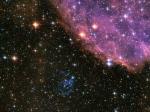 Supernova Remnant E0102 from Hubble
Supernova Remnant E0102 from Hubble
29.08.2006
It's the blue wisp near the bottom that's the remnant of a tremendous recent supernova explosion. The large pink structure looming to the upper right is part of N76, a large star forming region in our neighboring Small Magellanic Cloud (SMC) galaxy. The supernova remnant wisp, with full coordinate name 1E0102.
 Eight Planets and New Solar System Designations
Eight Planets and New Solar System Designations
28.08.2006
How many planets are in the Solar System? This popular question now has a new formal answer according the International Astronomical Union (IAU): eight. Last week, the IAU voted on a new definition for planet and Pluto did not make the cut.
 Barred Spiral Galaxy NGC 1300
Barred Spiral Galaxy NGC 1300
27.08.2006
Big, beautiful, barred spiral galaxy NGC 1300 lies some 70 million light-years away on the banks of the constellation Eridanus. This Hubble Space Telescope composite view of the gorgeous island universe is one of the largest Hubble images ever made of a complete galaxy.
 Apollo 17: VIP Site Anaglyph
Apollo 17: VIP Site Anaglyph
26.08.2006
Get out your red/blue glasses and check out this stereo scene from Taurus-Littrow valley on the Moon! The color anaglyph features a detailed 3D view of Apollo 17's Lunar Rover in the foreground -- behind it lies the Lunar Module and distant lunar hills.
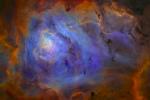 Blue Lagoon
Blue Lagoon
25.08.2006
Stars come and go as you slide your cursor over this engaging image of M8, aka the Lagoon Nebula. Of course, the nebula is itself a star-forming region, but the stars that appear and disappear here include background and foreground stars that by chance lie along the same line of sight.
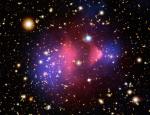 The Matter of the Bullet Cluster
The Matter of the Bullet Cluster
24.08.2006
The matter in galaxy cluster 1E 0657-56, fondly known as the "bullet cluster", is shown in this composite image. A mere 3.4 billion light-years away, the bullet cluster's individual galaxies are seen...
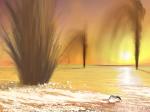 Sandy Gas Jets Hypothesized on Mars
Sandy Gas Jets Hypothesized on Mars
23.08.2006
What's causing seasonal dark spots on Mars? Every spring, strange dark spots appear near the Martian poles, and then vanish a few months later. These spots typically span 50 meters across and appear fan shaped. Recent observations made with THEMIS instrument onboard NASA's Mars Odyssey, currently orbiting Marscarbon dioxide (CO2) ice beneath them.
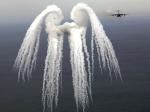 A Smoke Angel from Airplane Flares
A Smoke Angel from Airplane Flares
22.08.2006
What type of cloud is that? It is not a naturally occurring one. Looking perhaps a bit like a gigantic owl monster, the cloud pictured above resulted from a series of flares released by an air force jet over the Atlantic Ocean in May.
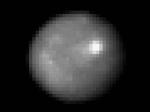 Ceres: Asteroid or Planet
Ceres: Asteroid or Planet
21.08.2006
Is Ceres an asteroid or a planet? Although a trivial designation to some, the recent suggestion by the Planet Definition Committee of the International Astronomical Union would have Ceres reclassified from asteroid to planet. A change in taxonomy might lead to more notoriety for the frequently overlooked world.
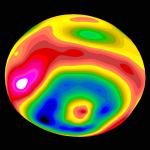 A Map of Asteroid Vesta
A Map of Asteroid Vesta
20.08.2006
Vesta is a huge rock 500 kilometers across that orbits out past Mars. In 1997, the above map of Vesta created using the Hubble Space Telescope was released showing a rugged surface highlighted by a single crater spanning nearly the entire length of the asteroid.
|
January February March April May June July August September October November December |
|||||||||||||||||||||||||||||||||||||||||||||||||